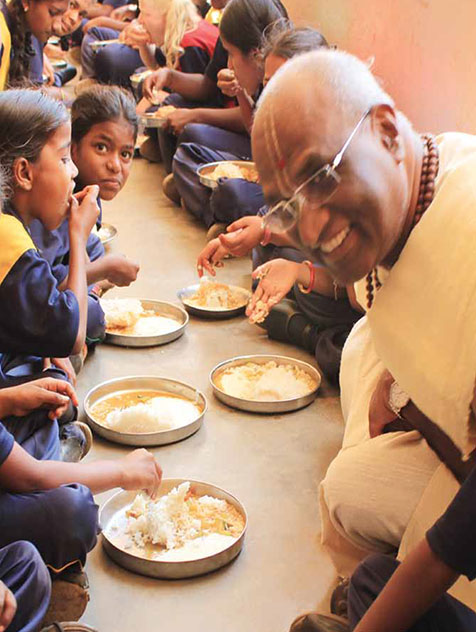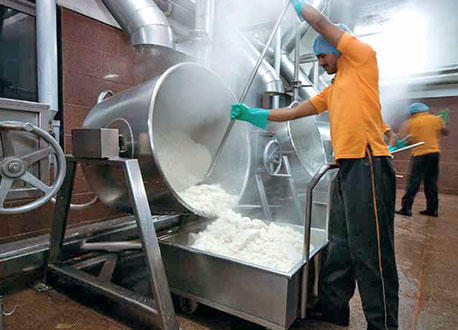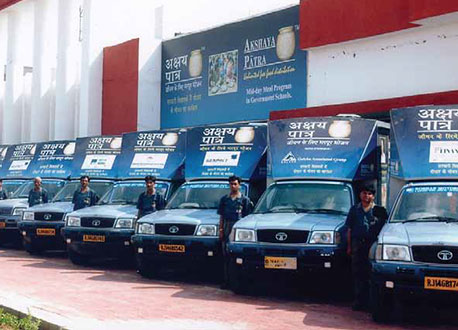‘We want to feed as many kids as possible’
Madhu Pandit Dasa is chairman of the Akshaya Patra Foundation, which operates the world’s largest NGO-run school lunch programme, feeding 1.7 million children in 14,173 schools across 35 locations in India.
Mr Dasa found his calling to spirituality more than three decades ago. Soon after graduating with an engineering degree from the Indian Institute of Technology (IIT) Bombay, he joined the International Society for Krishna Consciousness,where he was inspired by the biography of its founder, AC Bhaktivedanta Swami Prabhupada. The incident of the founder’s distress at seeing children fighting with stray dogs over scraps of food left an indelible impact on Mr Dasa and this led to the seeding of Akshaya Patra.
In this interview with Christabelle Noronha, Mr Dasa speaks about the challenges in getting Akshaya Patra off the ground, the efficiency practices that help make it a success and its future vision.
Is feeding the hungry a part of Indian culture?
According to Indian tradition, a householder cannot eat until he feeds the hungry people in the vicinity of his home. Sharing is common across all civilised cultures. It is part of the concept of seeing everyone as the same god, even though we might not be equals socially. The spirit that resides in each person cannot be categorised as Hindu, Muslim or Christian. Similarly, hunger pangs cannot be differentiated. Everyone feels it the same way.
You are an engineer by training. How did that help in getting Akshaya Patra midday meals programme off the ground?
Firstly, coming from an IIT background, we think like entrepreneurs and like to take up challenges. I was not aware of the extent of the problem of children going hungry. I realised that scale and technology would be crucial in finding a meaningful solution. Now, when you scale up, you need funds. We built a professional fund-raising team with this mission. The coming together of funding and technology has fuelled Akshaya Patra’s growth.
Many people are not aware that Akshaya Patra’s school lunch initiative was started before the launch of the government’s midday meal scheme. We began in 2000, two years before the Government of Karnataka started its programme. We were feeding 1,500 children and we gradually scaled up. Circumstances pushed us to see how we could raise funds professionally. We had the experience of raising funds as a charitable institution, but this was different.
Within three months, I had hundreds of letters from government schools around Bengaluru. The education department gave a figure of 700,000 children in government schools and they all needed food. Those days there was no cooked-meal programme. The government used to give 2kg of rice to parents every week, which, in many cases, never reached the children.
We decided that we should take this up on a larger scale. I used my engineering skills to conceptualise the first kitchen. I visited places where huge boilers and vessels were used for cooking. The capacity of the first kitchen we set up was for 30,000 meals.
What was the ingredient of success when you first started this? And who are your big donors?
I would say that without the spirited efforts of the missionary volunteers of the temple, this project would not have taken off. When we needed funds, the devotees and I raised it with pretty good success. This gave us confidence that people were willing to support us; we just had to trigger the spirit of compassion in them.
When we started the programme, it was not as the Akshaya Patra Foundation. The ISKCON temple was running it. After a year, I realised I had to set up a secular foundation independent of ISKCON. Within a year, we touched 100,000 beneficiaries. That’s when the government programme was initiated and it changed everything. It is only because of the partnership with the Indian government and the state governments that Akshaya Patra could take this programme to 1.7 million children.
The Supreme Court made it mandatory that midday meals be provided in all government and government-aided primary schools. How far has it become a reality?
The Supreme Court mandated that every child under the age of 14 years should be provided a hot midday meal in school. Initially, the progress of the implementation of the Supreme Court’s order was slow. Through persistent efforts, this has gradually improved. In the Union Budget of 2018-19, ![]() 105 billion is set aside for midday meals.
105 billion is set aside for midday meals.
Currently midday meals are served to children studying in class I to VIII. A few states like Telangana, Andhra Pradesh and Karnataka have extended this programme to class IX and X students. We need concerted advocacy efforts to engage with policymakers and influencers to extend the programme to include meals for older children.
What more can the government and government agencies do?
The government is expected to feed nearly 98 million children every school working day. The implementation of this programme on such a huge scale is a mammoth task. Government agencies need to invest more on hygiene, food safety and the addition of micronutrients needed for a nutritious meal. Several other factors, such as delivery of micronutrients and minerals, need further review.

1.7million
children getting nutritious food through the Akshaya Patra Foundation’s midday meal programme
12.46
cost in rupees of each meal the Akshaya Patra Foundation provides
5 million
target of children to be reached by 2020
14,173
number of schools that are part of the midday meal programme
35
number of locations, spread over 12 states, where the midday meals are prepared
6,900
number of people employed for the midday meal project
18
number of years the initiative has been running (it began in 2000 with one kitchen and 1,500 children)
High-quality food, proper hygiene and operational excellence are said to be the hallmarks of the Akshaya Patra programme. How did you get the equation right?
For us the quality initiative and food safety costs 37 paise per meal, compliance and governance 37 paise, and fund-raising and communications 60 paise. These are our investments and they do not come under the cost allocations of the government programme. Whether it is the quality of food in our kitchens or food safety compliance, there is a cost; that’s how it adds up to more than the government programme.
In addition, we strictly comply with the minimum wages requirement in every location we operate. The government programme includes an honorarium of ![]() 1,500-2,000 per month. Our cost of labour is much higher. Akshaya Patra personnel are paid an average salary of
1,500-2,000 per month. Our cost of labour is much higher. Akshaya Patra personnel are paid an average salary of ![]() 11,649.
11,649.
What was the turning point for Akshaya Patra in expanding the programme? What were the challenges in rural areas, compared with urban areas?
It is easier to run the programme in urban areas than in rural regions. The only solution is to get to each village, engage local women, rent a kitchen premise and deliver weekly supplies. We train women in self-help groups as per our quality assurance standards and they cook and serve the meals in schools. This provides employment to women and an opportunity for them to lead better lives.
We have rural outreach programmes in two places, Baran in Rajasthan and Nayagarh in Odisha. The number of children in these two places together will be about 35,000. While we can feed 200,000 children within the city of Bengaluru, in remote areas we have to cover larger geographies to feed even a fraction of this number.
With the Akshaya Patra culture of constant improvement, what lessons stand out from all that you have learned?
At Akshaya Patra, the entire process of food production and distribution works exactly like standard factory manufacturing operations in the food industry. We have about 6,900 employees and we get hundreds of suggestions. Employees are rewarded for suggestions and that makes a difference. Continuous innovation is a constant at Akshaya Patra.

For us the quality initiative and food safety costs 37 paise per meal, compliance and governance 37 paise, and fund-raising and communications 60 paise. These are our investments...”
The Tata Trusts have supported the foundation and you have other donors on your side. What are the critical factors in NGO-donor partnerships?
Every donor expects transparency and accountability from an NGO. A corporate foundation would not partner an NGO that does not follow this principle. Since inception, Akshaya Patra has demonstrated and upheld the highest standards of transparency, accountability and trustworthiness. We are a secular entity and we have strived to imbibe and implement every possible best practice in the industry.
Akshaya Patra’s goal is to feed 5 million children across the country by 2020. You seem to be on track to reach the target. What after that?
About 30 kitchens are in the pipeline, so we are very hopeful we will reach the 5 million mark. We don’t want to stop. We want to feed as many children as possible. We have a successful urban and semi-urban model, and we can scale it up by adding more locations.
Akshaya Patra can provide the best quality food for children but we have no control over the quality of education they receive. That’s why we have decided to start free schools where we can deliver high-quality education as well to talented students. We want to start two residential schools — one in the northeast and the other in Bengaluru — with 25,000 children each.

How has your relationship been with your donors?
The corporate sector started taking interest in 2009. Before that, there was no corporate participation, save for a few individuals from the corporate world, such as Sudha Murthy, Narayana Murthy and Gururaj Deshpande, who contributed from their personal funds. In 2005-06, Infosys Foundation contributed for building one of India’s largest kitchens (in Hubballi, Karnataka).
In December 2013, the Tata Trusts came on board as a donor and they have been very encouraging and supportive of Akshaya Patra. Instead of simply funding meals, they know exactly which segment in our model needs special funding, and they have made high-impact investments.
While we can feed 200,000 children within the city of Bengaluru, in remote areas we have to cover larger geographies to feed even a fraction of this number.
Akshaya Patra has been using the same machinery for four to five years. The Tata Trusts asked if we needed funds to replace our machinery and upgrade our technology. Ratan Tata committed a large sum of money to upgrading our kitchens with the latest in machines and technology. The Trusts understood that an organisation like Akshaya Patra would require more than just general donations.
What next for Akshaya Patra?
We are looking at training other NGOs to take up this cause and to share our good practices and experience in successfully handling challenges. We are open to teaching them every aspect of running the programme efficiently.
Akshaya Patra has been able to raise funds because of our focus on transparency, hygiene, cleanliness, compliance and sustainability. We can train willing organisations in all these aspects in partnership with the government.